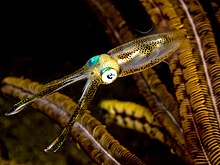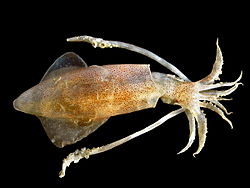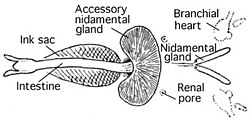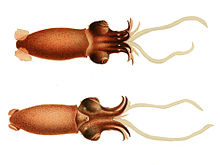This is an old revision of this page, as edited by M.O.X (talk | contribs) at 03:36, 8 October 2010 (Cleaned up using AutoEd). The present address (URL) is a permanent link to this revision, which may differ significantly from the current revision.
Revision as of 03:36, 8 October 2010 by M.O.X (talk | contribs) (Cleaned up using AutoEd)(diff) ← Previous revision | Latest revision (diff) | Newer revision → (diff) For other uses, see Squid (disambiguation).
| Squid Temporal range: (at least) Late Cretaceous–Recent PreꞒ Ꞓ O S D C P T J K Pg N | |
|---|---|

| |
| Bigfin Reef Squid, Sepioteuthis lessoniana | |
| Scientific classification | |
| Domain: | Eukaryota |
| Kingdom: | Animalia |
| Phylum: | Mollusca |
| Class: | Cephalopoda |
| Superorder: | Decapodiformes |
| Order: | Teuthida A. Naef, 1916 |
| Suborders | |
Squid are marine cephalopods of the order Teuthida, which comprises around 300 species. Like all other cephalopods, squid have a distinct head, bilateral symmetry, a mantle, and arms. Squid, like cuttlefish, have eight arms arranged in pairs and two, usually longer, tentacles. Squid are strong swimmers and certain species can 'fly' for short distances out of the water.
Modification from ancestral forms
Squid have differentiated from their ancestral molluscs such that the body plan has been condensed antero-posteriorly and extended dorso-ventrally. What before may have been the foot of the ancestor is modified into a complex set of tentacles and highly developed sense organs, including advanced eyes similar to those of vertebrates.
The ancestral shell has been lost, with only an internal gladius, or pen, remaining. The pen is a feather-shaped internal structure that supports the squid's mantle and serves as a site for muscle attachment. It is made of a chitin-like substance.
Anatomy

The main body mass is enclosed in the mantle, which has a swimming fin along each side. These fins, unlike in other marine organisms, are not the main source of locomotion in most species.
The skin is covered in chromatophores, which enable the squid to change color to suit its surroundings, making it effectively invisible. The underside is also almost always lighter than the topside, to provide camouflage from both prey and predator.
Under the body are openings to the mantle cavity, which contains the gills (ctenidia) and openings to the excretory and reproductive systems. At the front of the mantle cavity lies the siphon, which the squid uses for locomotion via precise jet propulsion. In this form of locomotion, water is sucked into the mantle cavity and expelled out of the siphon in a fast, strong jet. The direction of the siphon can be changed, to suit the direction of travel.
Inside the mantle cavity, beyond the siphon, lies the visceral mass, which is covered by a thin, membranous epidermis. Under this are all the major internal organs.
Nervous system
The giant axon, which may be up to 1 mm (0.04 inches) in diameter in some larger species, innervates the mantle and controls part of the jet propulsion system.
As cephalopods, squid exhibit relatively high intelligence among invertebrates. For example, groups of Humboldt squid hunt cooperatively, using active communication. (See Cephalopod intelligence.)
Reproductive system
Template:Image stack In females the ink sac is hidden from view by a pair of white nidamental glands, which lie anterior to the gills. There are also red-spotted accessory nidamental glands. Both organs are associated with food manufacture and shells for the eggs. Females also have a large translucent ovary, situated towards the posterior of the visceral mass.
Males do not possess these organs, but instead have a large testis in place of the ovary, and a spermatophoric gland and sac. In mature males, this sac may contain spermatophores, which are placed inside the female's mantle during mating.
Shallow water species of the continental shelf and epipelagic/mesopelagic zones are characterised by the presence of hectocotyli, specially modified arms used to fertilise the female's eggs. Most deep sea squid lack hectocotyli and have longer penises; Ancistrocheiridae and Cranchiinae are exceptions. Giant squid of the genus Architeuthis are unusual in that they possess both a large penis and modified arm tips, although it is uncertain whether the latter are used for spermatophore transfer. Penis elongation has been observed in the deep water species Onykia ingens; when erect, the penis may be as long as the mantle, head and arms combined. As such, deep water squid have the greatest known penis length relative to body size of all mobile animals, second in the entire animal kingdom only to certain sessile barnacles.
Digestive system
Like all cephalopods, squid have complex digestive systems. The muscular stomach is found roughly in the midpoint of the visceral mass. From there, the bolus moves into the caecum for digestion. The caecum, a long, white organ, is found next to the ovary or testis. In mature squid, more priority is given to reproduction such that the stomach and caecum often shrivel up during the later life stages. Finally, food goes to the liver (or digestive gland), found at the siphon end, for absorption. Solid waste is passed out of the rectum. Beside the rectum is the ink sac, which allows a squid to rapidly discharge black ink into the mantle cavity.

Cardiovascular system
Squid have three hearts. Two brachial hearts feed the gills, each surrounding the larger systemic heart that pumps blood around the body. Squid blood contains the copper-rich protein hemocyanin for transporting oxygen. The faintly greenish hearts are surrounded by the renal sacs - the main excretory system. The kidneys are difficult to identify and stretch from the hearts (located at the posterior side of the ink sac) to the liver. The systemic heart is made of three chambers, a lower ventricle and two upper auricles.
Head
The head end bears 8 arms and 2 tentacles, each a form of muscular hydrostat containing many suckers along the edge. These tentacles do not grow back if severed. In the mature male, one basal half of the left ventral tentacle is hectocotylised — and ends in a copulatory pad rather than suckers. It is used for intercourse.
The mouth is equipped with a sharp horny beak mainly made of chitin and cross-linked proteins, and is used to kill and tear prey into manageable pieces. The beak is very robust, but does not contain minerals, unlike the teeth and jaws of many other organisms, including marine species. Captured whales often have indigestible squid beaks in their stomachs. The mouth contains the radula (the rough tongue common to all molluscs except bivalvia and aplacophora).
The eyes, on either side of the head, each contain a hard lens. The lens is focused through movement, much like the lens of a camera or telescope, rather than changing shape as the lens in the human eye does.
Squids appear to have limited hearing.
Size

The majority are no more than 60 centimetres (24 in) long, although the giant squid may reach 13 metres (43 ft).
In 1978, sharp, curved claws on the suction cups of squid tentacles cut up the rubber coating on the hull of the USS Stein. The size suggested the largest squid known at the time.
In 2003, a large specimen of an abundant but poorly understood species, Mesonychoteuthis hamiltoni (the Colossal Squid), was discovered. This species may grow to 14 metres (46 ft) in length, making it the largest invertebrate. Squid have the largest eyes in the animal kingdom. Giant squid are featured in literature and folklore with a frightening connotation. The Kraken is a legendary tentacled monster possibly based on sightings of real giant squid.
In February 2007, a New Zealand fishing vessel caught a Colossal Squid weighing 495 kilograms (1,091 lb) and measuring around 10 metres (33 ft) off the coast of Antarctica. This specimen represents the largest cephalopod to ever be scientifically documented.
Classification






Squid are members of the class Cephalopoda, subclass Coleoidea, order Teuthida, of which there are two major suborders, Myopsina and Oegopsina (including giant squids like Architeuthis dux). Teuthida is the largest cephalopod order with around 300 classified into 29 families.
The order Teuthida is a member of the superorder Decapodiformes (from the Greek for "ten legs"). Two other orders of decapodiform cephalopods are also called squid, although they are taxonomically distinct from Teuthida and differ recognizably in their gross anatomical features. They are the bobtail squid of order Sepiolida and the ram's horn squid of the monotypic order Spirulida. The vampire squid, however, is more closely related to the octopuses than to any squid.
- CLASS CEPHALOPODA
- Subclass Nautiloidea: nautilus
- Subclass Coleoidea: squid, octopus, cuttlefish
- Superorder Octopodiformes
- Superorder Decapodiformes
- ?Order †Boletzkyida
- Order Spirulida: Ram's Horn Squid
- Order Sepiida: cuttlefish
- Order Sepiolida: bobtail squid
- Order Teuthida: squid
- Family †Plesioteuthididae (incertae sedis)
- Suborder Myopsina
- Family Australiteuthidae
- Family Loliginidae: inshore, calamari, and grass squid
- Suborder Oegopsina
- Family Ancistrocheiridae: Sharpear Enope Squid
- Family Architeuthidae: giant squid
- Family Bathyteuthidae
- Family Batoteuthidae: Bush-club Squid
- Family Brachioteuthidae
- Family Chiroteuthidae
- Family Chtenopterygidae: comb-finned squid
- Family Cranchiidae: glass squid
- Family Cycloteuthidae
- Family Enoploteuthidae
- Family Gonatidae: armhook squid
- Family Histioteuthidae: jewel squid
- Family Joubiniteuthidae: Joubin's Squid
- Family Lepidoteuthidae: Grimaldi Scaled Squid
- Family Lycoteuthidae
- Family Magnapinnidae: bigfin squid
- Family Mastigoteuthidae: whip-lash squid
- Family Neoteuthidae
- Family Octopoteuthidae
- Family Ommastrephidae: flying squid
- Family Onychoteuthidae: hooked squid
- Family Pholidoteuthidae
- Family Promachoteuthidae
- Family Psychroteuthidae: Glacial Squid
- Family Pyroteuthidae: fire squid
- Family Thysanoteuthidae: rhomboid squid
- Family Walvisteuthidae
- Parateuthis tunicata (incertae sedis)
Commercial fishing
According to the FAO, the cephalopod catch for 2002 was 3,173,272 tonnes (6.995867×10 lb). Of this, 2,189,206 tonnes, or 75.8 percent, was squid. The following table lists the squid species fishery catches which exceeded 10,000 tonnes (22,000,000 lb) in 2002.
| World squid catch in 2002 | ||||
| Species | Family | Common name | Catch tonnes |
Percent |
|---|---|---|---|---|
| Loligo gahi | Loliginidae | Patagonian squid | 24,976 | 1.1 |
| Loligo pealei | Loliginidae | Longfin squid | 16,684 | 0.8 |
| Common squids nei | Loliginidae | 225,958 | 10.3 | |
| Ommastrephes bartrami | Ommastrephidae | Neon flying squid | 22,483 | 1.0 |
| Illex argentinus | Ommastrephidae | Argentine shortfin squid | 511,087 | 23.3 |
| Dosidicus gigas | Ommastrephidae | Jumbo flying squid | 406,356 | 18.6 |
| Todarodes pacificus | Ommastrephidae | Japanese flying squid | 504,438 | 23.0 |
| Nototoda russloani | Ommastrephidae | Wellington Flying Squid | 62,234 | 2.8 |
| Squids nei | Various | 414,990 | 18.6 | |
| Total squid | 2,189,206 | 100.0 | ||
As food
Main article: Squid (food)
Many species are popular as food in cuisines as diverse as Chinese, Greek, Turkish, Japanese, Portuguese, Italian, Spanish, Korean, Indian, and Filipino.
In English-speaking countries, squid as food is often marketed using the Italian word calamari. Squid are found abundantly in certain areas, and provide large catches for fisheries. The body can be stuffed whole, cut into flat pieces or sliced into rings. The arms, tentacles and ink are also edible; in fact, the only parts that are not eaten are the beak and gladius (pen). Squid is a good food source for zinc, manganese and high in the recommended daily intake of copper, selenium, vitamin B12, and riboflavin.
See also
Template:Misplaced Pages-Books
References
- Tanabe, K.; Hikida, Y.; Iba, Y. (2006). "Two Coleoid Jaws from the Upper Cretaceous of Hokkaido, Japan". Journal of Paleontology. 80 (1): 138–145. doi:10.1666/0022-3360(2006)080[0138:TCJFTU]2.0.CO;2.
- Jabr, F. 2010. Fact or Fiction: Can a Squid Fly Out of the Water? Scientific American, August 2, 2010.
- ^ Arkhipkin, A.I. & V.V. Laptikhovsky 2010. Observation of penis elongation in Onykia ingens: implications for spermatophore transfer in deep-water squid. Journal Molluscan Studies, published online on June 30, 2010. doi:10.1093/mollus/eyq019
- Walker, M. 2010. Super squid sex organ discovered. BBC Earth News, July 7, 2010.
- Clarke, M.R. (1986). A Handbook for the Identification of Cephalopod Beaks. Oxford: Clarendon Press. ISBN 0-19-857603-X.
-
Miserez, A (2007). "Jumbo squid beaks: Inspiration for design of robust organic composites". Acta Biomaterialia. 3: 139–149. doi:10.1016/j.actbio.2006.09.004.
{{cite journal}}: Unknown parameter|coauthors=ignored (|author=suggested) (help) - Matt Walker (15 June 2009). "The cephalopods can hear you". BBC. Retrieved 2010-04-02.
-
O'Shea, S. (2003.). "Giant Squid and Colossal Squid Fact Sheet". The Octopus News Magazine Online.
{{cite web}}: Check date values in:|date=(help) - Johnson, C. Scott "Sea Creatures and the Problem of Equipment Damage" United States Naval Institute Proceedings August 1978 pp.106-107
- Xavier, J.C., P.G. Rodhouse, P.N. Trathan & A.G. Wood 1999. Template:PDF Antarctic Science 11:61-62. online version
-
Anderton, H.J. (2007.). "Amazing specimen of world's largest squid in NZ". New Zealand Government website.
{{cite web}}: Check date values in:|date=(help) - "Microwave plan for colossal squid". BBC News. March 22, 2007.
- ^
Rodhouse, Paul G (2005). "Review of the state of world marine fishery resources: Fisheries technical paper". World squid resources (447). FAO. ISBN 95-5-105267-0.
{{cite journal}}: Check|isbn=value: checksum (help) - ^ nei: not elsewhere included
- http://www.foodmarketexchange.com/datacenter/product/seafood/squid/detail/dc_pi_sf_squid_0204.htm
- http://www.nmfs.noaa.gov/fishwatch/species/market_squid.htm
External links
- CephBase: Teuthida
- Colossal Squid at the Museum of New Zealand Te Papa Tongarewa
- Market squid mating, laying eggs (video)
- Scientific American - Giant Squid
- The Cephalopod Page
- The Octopus News Magazine Online
| Principal commercial fishery species groups | ||||||||||||||||||||
|---|---|---|---|---|---|---|---|---|---|---|---|---|---|---|---|---|---|---|---|---|
| Wild |
|    | ||||||||||||||||||
| Farmed | ||||||||||||||||||||
| Edible mollusks | |||||||||||||||||||
|---|---|---|---|---|---|---|---|---|---|---|---|---|---|---|---|---|---|---|---|
| Bivalves |
| ||||||||||||||||||
| Gastropods |
| ||||||||||||||||||
| Inkfish |
| ||||||||||||||||||
| Chitons | |||||||||||||||||||
| Related topics | |||||||||||||||||||
| Category | |||||||||||||||||||